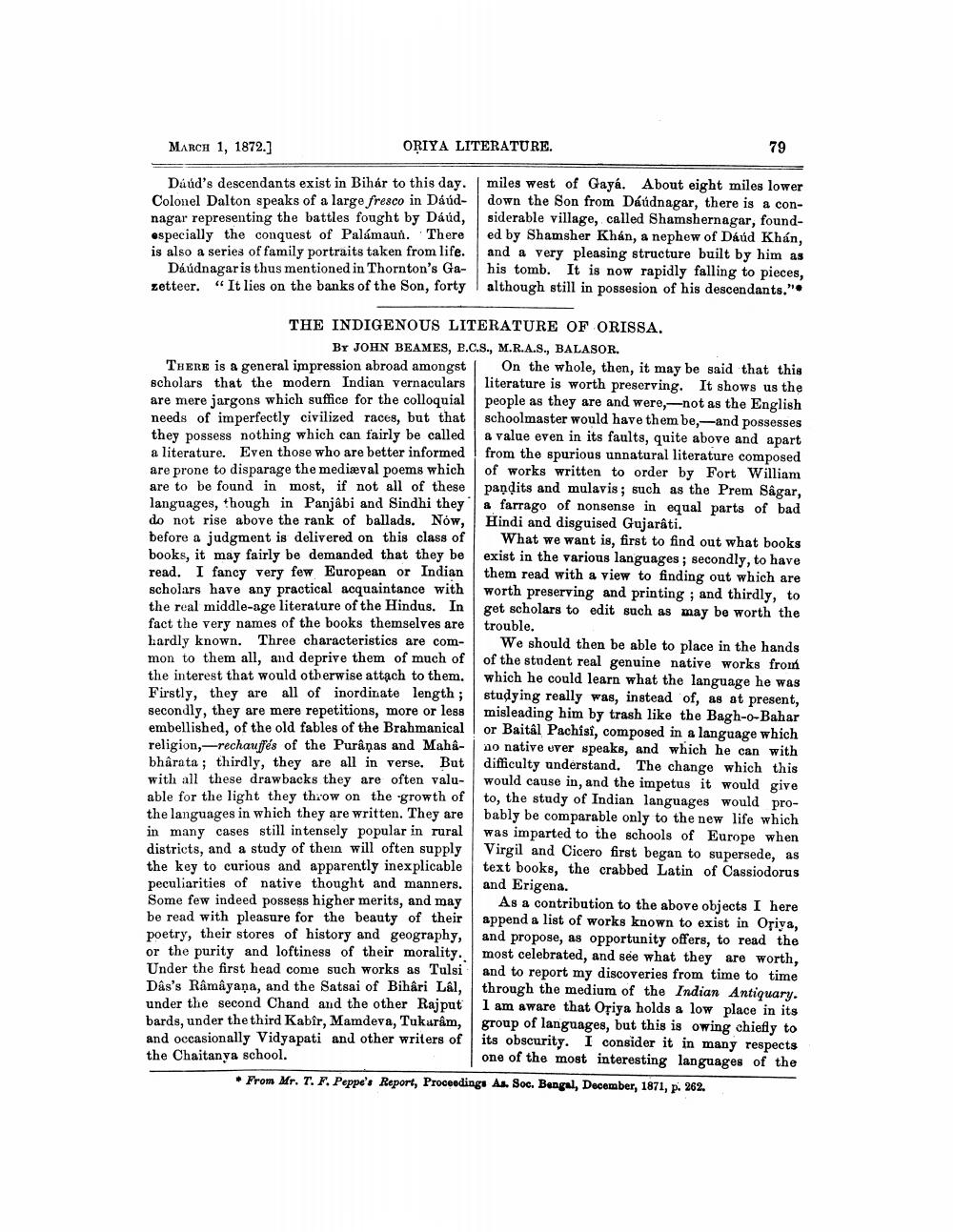________________
MARCH 1, 1872.)
ORIYA LITERATURE.
79
Dáúd's descendants exist in Bihár to this day. miles west of Gaya. About eight miles lower Colonel Dalton speaks of a large fresco in Dáúd- down the Son from Dáúdnagar, there is a connagar representing the battles fought by Dáúd, siderable village, called Shamshernagar, foundespecially the conquest of Palámaun. There ed by Shamsher Khán, a nephew of Dáúc Khán, is also a series of family portraits taken from life. and a very pleasing structure built by him as
Dáúdnagaris thus mentioned in Thornton's Ga- his tomb. It is now rapidly falling to pieces, zetteer. “It lies on the banks of the Son, forty although still in possesion of his descendants."
THE INDIGENOUS LITERATURE OF ORISSA.
BY JOHN BEAMES, B.C.S., M.R.A.S., BALASOR. THERE is a general impression abroad amongst On the whole, then, it may be said that this scholars that the modern Indian vernaculars literature is worth preserving. It shows us the are mere jargons which suffice for the colloquial people as they are and were,-not as the English needs of imperfectly civilized races, but that schoolmaster would have them be,--and possesses they possess nothing which can fairly be called a value even in its faults, quite above and apart a literature. Even those who are better informed from the spurious unnatural literature composed are prone to disparage the medieval poems which of works written to order by Fort William are to be found in most, if not all of these pandits and mulavis; such as the Prem Sagar, languages, though in Panjabi and Sindhi theya farrago of nonsense in equal parts of bad do not rise above the rank of ballads. Now, Hindi and disguised Gujarati. before a judgment is delivered on this class of What we want is, first to find out what books books, it may fairly be demanded that they be exist in the various languages; secondly, to have read. I fancy very few European or Indian them read with a view to finding out which are scholars have any practical acquaintance with worth preserving and printing ; and thirdly, to the real middle-age literature of the Hindus. In get scholars to edit such as may be worth the fact the very names of the books themselves are hardly known. Three characteristics are com- We should then be able to place in the hands mon to them all, and deprive them of much of of the student real genuine native works froin the interest that would otherwise attach to them. which he could learn what the language he was Firstly, they are all of inordinate length; studying really was, instead of, as at present, secondly, they are mere repetitions, more or less misleading him by trash like the Bagh-o-Bahar embellished, of the old fables of the Brahmanical or Baital Pachisi, composed in a language which religion, -rechauffés of the Puranas and Maha- ao native uver speaks, and which he can with bharata ; thirdly, they are all in verse. But difficulty understand. The change which this with all these drawbacks they are often valu- would cause in, and the impetus it would give able for the light they throw on the growth of to, the study of Indian languages would pro
he languages in which they are written. They are bably be comparable only to the new life which in many cases still intensely popular in rural was imparted to the schools of En districts, and a study of thein will often supply Virgil and Cicero first began to supersede, as the key to curious and apparently inexplicable text books, the crabbed Latin of Cassiodorus peculiarities of native thought and manners. and Erigena. Some few indeed possess higher merits, and may As a contribution to the above objects I here be read with pleasure for the beauty of their append a list of works known to exist in Oriya, poetry, their stores of history and geography, and propose, as opportunity offers, to read the or the purity and loftiness of their morality.. most celebrated, and see what they are worth, Under the first head come such works as Tulsi and to report my discoveries from time to time Dâs's Râmâyana, and the Satsai of Bihari Lal, through the medium of the Indian Antiquary. under the second Chand and the other Rajput | 1 am aware that Osiya holds a low place in its bards, under the third Kabîr, Mamdeva, Tukurêm, group of languages, but this is owing chiefly to and occasionally Vidyapati and other writers of its obscurity. I consider it in many respects the Chaitanya school.
S o ne of the most interesting languages of the • From Mr. T. F. Peppe's Report, Proceedings As. Soc. Bengal, December, 1871, p. 262.




